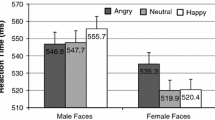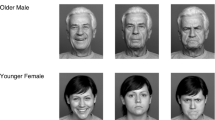Abstract
Gender differences in the reported intensity of anger and fear toward hypothetical males and females were explored in three age groups (6–12 year olds, 14–16 year olds, and adults over 30) located in two different geographic areas. The samples were primarily Caucasian and included a wide range of socioeconomic groups. Subjects reported on the intensity of feelings elicited by characters in an emotion story task in which three aspects of situational context were varied: the gender of the story characters eliciting the feeling (all situations), the stereotypic gender-typed or cross-gender behavior of the eliciting character (four situations), and the affective quality of the situations (four situations). Across all three age groups, situations that were frightening, anger-provoking, or that depicted stereotypic male-negative behavior elicited the most consistent subject gender and character gender differences in reported fear and anger. Relative to males, females of all ages reported more fear in frightening, anger-producing, and male-negative stereotypic situations. Males were reported to be more frightening and anger-producing than were females in those same situations. The data also suggested that with development, females reported less intense fear of females, while males reported less intense fear of males.
Similar content being viewed by others
References
Albert, A., & Porter, J. (1983). Age patterns in the development of children's sex role stereotypes.Sex Roles, 9, 59–67.
Allen, J. G., & Haccoun, D. M. (1976). Sex differences in emotionality: A multidimensional approach.Human Relations, 29, 711–722.
Averill, J. R. (1983). Studies on anger and aggression: Implications for theories of emotion.American Psychologist, 38, 1145–1160.
Blier, M. J., & Blier-Wilson, L. A. (1989). Gender differences in self-rated emotional expressiveness.Sex Roles, 21, 287–295.
Blishen, B. R., Carroll, W. K., & Moore, C. (1987). The 1981 socioeconomic index for occupations in Canada.Canadian Review of Sociology and Anthropology, 24, 465–488.
Brody, L. R. (1993). On understanding gender differences in the expression of emotion: Gender roles, socialization and language. In S. Ablon, D. Brown, E. Khantzian, & J. Mack (Eds.),Human feelings: Explorations in affect development and meaning. New Jersey: Analytic Press.
Brody, L. R. (1985). Gender differences in emotional development: A review of theories and research.Journal of Personality, 53, 102–149.
Brody, L. R., & Carter, A. (1982). Children's emotional attributions to self versus other: An exploration of an assumption underlying projective techniques.Journal of Consulting and Clinical Psychology, 50, 665–671.
Brody, L. R., & Hall, J. (1993). Gender and emotion. In M. Lewis & J. Haviland (Eds.),Handbook of emotion. New York: Guilford Press.
Brody, L. R., & Harrison, R. (1987). Developmental changes in children's abilities to match and label emotionally laden situations.Motivation and Emotion, 11, 347–365.
Brody, L. R., Hay, D. H., & Vanderwater, E. (1990). Gender, gender-role identity and children's reported feelings toward the same and opposite gender.Sex Roles, 23, 363–387.
Crandall, V. C., Crandall, V. J., & Katkovsky, W. (1965). A children's social desirability questionnaire.Journal of Consulting Psychology, 29, 27–36.
Croake, J. W., Myers, K. M., & Singh, A. (1987). Demographic features of adult fears.International Journal of Social Psychiatry, 33, 285–293.
Crowne, D., & Marlowe, D. (1960). A new scale of social desirability independent of psychopathology.Journal of Consulting Psychology, 24, 349–354.
Cunningham, J. A., Strassberg, D. S., & Haan, B. (1986). Effects of intimacy and sex-role congruency of self-disclosure.Journal of Social and Clinical Psychology, 4, 393–401.
Diener, E., Sandvik, E., & Larsen, R. (1985). Age and sex effects for emotional intensityDevelopmental Psychology, 21, 542–546.
Dillon, K. M., Wolf, E., & Katz, H. (1985). Sex roles, gender, and fear.The Journal of Psychology, 119, 355–359.
Eisenberg, N., & Lennon, R. (1983). Sex differences in empathy and related constructs.Psychological Bulletin, 94, 100–131.
Fischer, K., Shaver, P., & Carnochan, P. (1989). A skill approach to emotional development: From basic to subordinate category emotions. In W. Damon (Ed.),Child development today and tomorrow. San Francisco: Jossey-Bass.
Fujita, F., Diener, E., & Sandvik, E. (1991). Gender differences in negative affect and well being: The case for emotional intensity.Journal of Personality and Social Psychology, 61, 427–434.
Gergen, K., & Marlowe, D. (1970).Personality and social behavior. Reading, MA: Addison-Wesley.
Glick, P. (1988). Fifty years of family demography: A record of social change.Journal of Marriage and the Family, 50, 861–873.
Gordis, F., Smith, J., & Mascio, C. (April, 1991).Gender differences in attributions of sadness and anger. Poster presented at the biennial meeting of the Society for Research in Child Development, Seattle, WA.
Hall, J. A. (1987). On explaining gender differences: The case of nonverbal communication. In P. Shaver & Hendrick (Eds.),Review of personality and social psychology: Sex and gender (Vol. 7). Newbury Park, CA: Sage Publications.
Hayden-Thomson, L., Rubin, K., & Hymel, S. (1987). Sex preferences in sociometric choices.Developmental Psychology, 23, 558–562.
Highlen, P. S., & Gilles, S. F. (1978). Effects of situational factors, sex and attitude on affective self-disclosure with acquaintances.Journal of Counseling Psychology, 25, 270–276.
Highlen, P. S., & Johnston, B. (1979). Effects of situational variables on affective self-disclosure with acquaintances.Journal of Counseling Psychology, 26, 255–258.
Hollingshead, A. B., & Redlich, F. C. (1958).Social class and mental illness. New York: John Wiley & Sons.
Hyde, J. S. (1986). Gender differences in aggression. In J. S. Hyde & M. Linn (Eds.),The psychology of gender: Advances through meta-analysis. Baltimore, MD: Johns Hopkins University Press.
Inoff, G. E., Halverson, C. F., & Pizzigale, K. (1983). The influence of children's sex role stereotypes on children's self and peer attributions.Sex Roles, 9, 1205–1222.
Kirkpatrick, D. R. (1984). Age, gender and patterns of common intense fear among adults.Behavior Research and Therapy, 22, 141–150.
Malatesta, C. Z. (1988). The role of emotions in the development and organization of personality. In R. Thompson (Ed.),Nebraska Symposium of Motivation: Socioemotional development. Lincoln: University of Nebraska Press.
Mandler, H. (1975).Mind and emotion. New York: John Wiley & Sons.
Martin, C. L. (1989). Children's use of gender-related information in making social judgments.Developmental Psychology, 25, 80–86.
McCallum, D. M., Box, D., Butgereit, A., Smith, L., & Threatt, S. (1985). Attraction to cross-gender-role behavior in advertising.Journal of Social Behavior and Personality, 1, 37–46.
Perry, D. G., White, A. J., & Perry, L. C. (1984). Does early sex typing result from children's attempts to match their behavior to sex role stereotypes?Child Development, 55, 2114–2121.
Rehm, L. P. (1978). Mood, pleasant events, and unpleasant events: Two pilot studies.Journal of Consulting and Clinical Psychology, 46, 854–859.
Scher, D. (1984). Sex-role contradictions: Self-perceptions and ideal perceptions.Sex Roles, 10, 651–656.
Smetana, J. G. (1986). Preschool children's conceptions of sex-role transgressions.Child Development, 57, 862–871.
Sommers, S., & Kosmitzki, C. (1988). Emotion and social context: An American-German comparison.British Journal of Social Psychology, 27, 35–49.
Stapley, J., & Haviland, J. (1989). Beyond depression: Gender differences in normal adolescents' emotional experiences.Sex Roles, 20, 295–309.
Tangney, J. P. (1990). Assessing individual differences in proneness to shame and guilt: Development of the Self Conscious Affect and Attribution Inventory.Journal of Personality and Social Psychology, 59, 102–111.
Walsh, J. A., Tomlinson-Keasy, C., & Klieger, D. (1974). Acquisition of the social desirability response.Genetic Psychology Monographs, 89, 241–272.
Wintre, M. G., Polivy, J., & Murray, M. (1990). Self predictions of emotional response patterns: Age, sex, and situational determinants.Child Development, 61, 1124–1133.
Zalk, S. R., & Katz, P. (1978). Gender attitudes in children.Sex Roles, 4, 349–357.
Author information
Authors and Affiliations
Additional information
This research was supported by a Gender Roles grant from the Rockefeller Foundation. We appreciate their support. We would also like to thank the public school systems of Milton, Norwood, and Watertown, Massachusetts, and Saskatoon, Saskatchewan, Canada. Finally, we would like to thank Lance Davidow, John Houlihan, and Theodore Cross for statistical consultation and/or computer programming, as well as all the parents, children, and adolescents who participated in the study.
Rights and permissions
About this article
Cite this article
Brody, L.R., Lovas, G.S. & Hay, D.H. Gender differences in anger and fear as a function of situational context. Sex Roles 32, 47–78 (1995). https://doi.org/10.1007/BF01544757
Issue Date:
DOI: https://doi.org/10.1007/BF01544757




